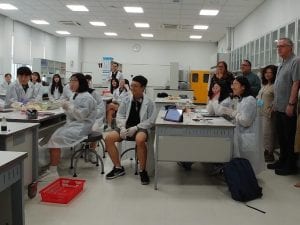During the summer months, many of our staff take the opportunity to engage in professional development – the school superintendent is no exception. I was invited by the South Korean Consulate in New York City to travel to South Korea to better understand the importance of Korean as a world language. The trip was generously paid for by the South Korean Ministry of Education. The purpose of the visit was to encourage U.S. superintendents to initiate Korean language instruction as part of their world language program offerings. Certainly, I was excited to explore and investigate this possibility but was also curious to better understand the South Korean system of public education. My curiosity stemmed from the fact that South Korea has consistently ranked in the “top ten” PISA listing of scholastic performance for many years. The Program for International Student Assessment (PISA) is a worldwide study by OECD in 70 nations of 15-year-old students’ scholastic performance on mathematics, science and reading.
While I was in South Korea, I had the opportunity to learn more about the Korean system of K-12 education. South Korea has one of the highest literacy rates and high school graduation rates (99.9 and 99.7 respectively) and college graduation rates (68%). These metrics are very impressive and I have always been curious to know what these schools do differently than our schools in the United States. I hypothesize that literacy rates are a function of all students in South Korea having equal access to educational resources regardless of variables such as wealth. In the United States, for example, there is a strong relationship between wealth/income and literacy rates.
However, I also learned something that was shockingly sad. Alarmingly, South Korea also has one of the highest suicide rates for students aged 10-19 and this has been correlated to the system that is known as “Hagwon” or “cram schools” to prepare students for entry into one of the S-K-Y universities (Seoul National, University of Korea, and Yonsei). Suicide is the leading cause of death of school-aged children in Korea. While I did not observe anything particularly extraordinary about the process of instruction in the public schools that I visited compared to those with which I am familiar in the U.S., I learned that most of this educational fervor is the result of preparing to take the national college entrance examinations. The private Hagwon tutoring sessions run from 7:00 to 11:30 p.m. after school – which is when the students seem to be educated more in earnest than during the normal school day.
While I don’t like to make generalizations, my observations did serve to reinforce my concerns against over-reliance on high-stakes testing and the injurious impact that such tests have on students. Many South Korean educators and families with whom I spoke are hopeful that their system of public education will start to move away from the grim “examination nightmare” presented by their emphasis on stressful college entrance examinations.
The South Orangetown Central School District has always sought opportunities to strengthen our relationships with “sister schools” overseas with our existing programs to foster global awareness. For example, we currently have partnerships through IVECA (see website at http://website.iveca.org/ ). I am hopeful that educators from both of our countries will continue to learn and grow from each other and that all of our students will be better prepared to thrive in a global economy.

